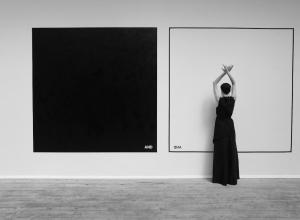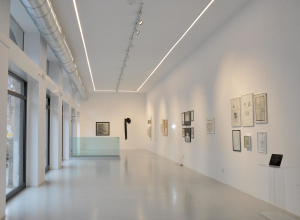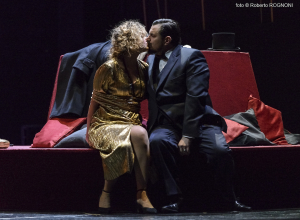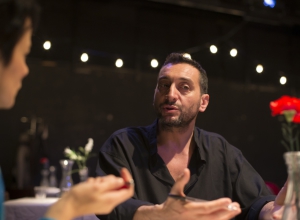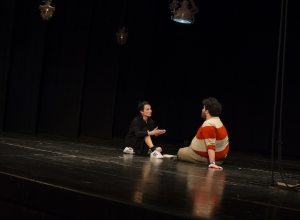#DEFINE IDENTITY
Un’immersione, profonda, nell’arte che ha per materiali i concetti. Un tuffo di testa per provare a capire la provocazione di un’arte che inverte la funzione di sè stessa, per cui non è più, esclusivamente, un rapporto di armonia e bellezza con il mondo, non assolve più solamente ad una funzione decorativa, ma inizia ad instaurare un rapporto di conoscenza con il mondo. Un’ indagine e la sperimentazione irrequieta, eclettica, che ne è conseguita. Un percorso lungo quasi una vita e la sua narrazione non lineare, eppure armonica, poetica perfino, nella mano di colui che sa dipingere il denaro. Antonio Syxty, tante identità. Artista, performer, regista di teatro e di cinema, co-direttore artistico del Litta di Milano. E la sua arte, un puzzle di tanti pezzi ad incastro variabile, come variabile è la nostra identità. “L’identità non è una ma la nostra identità si scompone in tante identità e queste identità assumono dei comportamenti che sono magari opposti alla nostra identità originaria. Di fondo la percezione che sia possibile falsificare l’identità o portarla in una zona in cui l’identità non corrisponde più a quella vera ma è un’identità inventata.” Una fascinazione, quella per l’identità, che affonda le radici nel lavoro di Marcel Duchamp e nell’interesse di lui per la scomposizione della forma e del linguaggio in relazione al comportamento umano. “Quello che mi ha sempre interessato è il situazionismo e il comportamentismo, anche nell’arte. Avevo esigenza di vedere e conoscere il mondo in una maniera diversa, analizzandolo sotto il punto di vista del comportamento degli esseri umani per trovare l’aspetto euforico del comportamento.” Le prime pratiche artistiche di Antonio Syxty sono indirizzate alla performance, con esplicito riferimento alla reiterazione dei gesti. Si pensi al suo “108 modi di salare il sale”. Il sale come simbolo, il sale della vita (uno degli pseudonimi di Marcel Duchamp era proprio il Mercante di sale), il sale pretesto per la reiterazione di uno stesso gesto, reiterazione di una stessa domanda: il sale può essere salato dal sale? “L’ aspetto del cambio di identità e della falsificazione della propria identità mi ha portato poi sempre più a incrociare per caso, dopo le mie performance degli esordi, l’idea che potesse forse essere il teatro la zona dove poter studiare più da vicino la falsificazione dell’identità.” Il perimetro artistico è quello del Living Theatre e di Grotowski. Uno spazio di tempo in cui il teatro ardentemente desidera sovvertire i canoni della forma classica, borghese e uno spazio di società che si riempie della Guerra del Vietnam, della rivoluzione studentesca, di radicali cambiamenti. “Lo studio mio personale del teatro di quell’epoca unito al comportamento nell’arte di artisti quail Vito Acconci, Urs Luthi, Gina Pane, tutta la body art, ha fatto si che io provassi a frequentare una scuola di teatro per imparare come si fa a falsificare l’identità. Perchè infondo l’attore falsifica la propria identità, assume un’altra identità e la ripropone pur rimanendo lui sè stesso. Non ho mai fatto l’attore, ma ho messo in scena delle performance teatrali fino agli anni ‘80 inoltrati per poi assestarmi nella professione di regista interessandomi al cinema, alla televisione, ai media, al linguaggio in generale, con un approcio cross-mediale.” Ma scompattare la visione del reale per permettere all’arte di assolvere in pieno alla sua funzione richiede, nel percorso di Antonio Syxty, ulteriori sperimentazioni del linguaggio che esulino dalla forma codificata della regia. Fuori dalla cortina di ferro delle regole, ancora immersione, in un oceano di libertà stilistica questa volta. Dentro il suo “Visioni di Solaris” alla ricerca di un’idea più performativa del teatro, fatta di narrazione non lineare a episodi in cui è il pubblico stesso a crearsi un percorso percettivo e narrativo. Perchè “l’ arte dovrebbe avere la funzione di rendere irriconoscibile quello che vediamo, dovrebbe stimolare una nuova visione del mondo attraverso quella inconoscibilità del mondo stesso. Attraverso quel mistero che è l’opera d’arte si dovrebbe poter ri-formulare l’idea della visione del mondo.” Un viaggio di andata e ritorno il suo. Dall’arte verso il teatro e dal teatro di nuovo verso l’arte, come meglio di me ha scritto Luna Gay Esmeralda. “Riprendendo in mano l’arte, dopo Visioni di Solaris, penso al denaro come lo strumento che più condiziona il comportamento della nostra vita. Perchè qualunque cosa facciamo è relativa al denaro. Se parliamo di guerra parliamo di denaro. Ma se parliamo di pace parliamo di denaro allo stesso modo. Così il denaro, l’economia, ho deciso di dipingerli.” Con il progetto Money Transfer Antonio Syxty prosegue la sua acuta riflessione sul tema identitario incrociando un’interessante riflessione sul tema del denaro, della sua impalpabilità e della sua sparizione, della sparizione della carta moneta. Sparisce il denaro in quanto oggetto fisico e viene sostituito dalla carta di credito che è la prima forma di impalpabilità del denaro. “Se ci pensi metto una targhetta di plastica dentro un’altra cosa di plastica ed esco con un paio di pantaloni. Questo aspetto è una cosa molto interessante perchè quando una cosa, nel nostro caso il denaro, sparisce significa che è diventata molto importante.” La carta di credito come possible forma identitaria. Nella carta di credito, che in realtà è una carta di debito, sono contenuti tutti i nostri dati, sono tracciate le nostre azioni, i nostri gusti, perfino le nostre emozioni perchè “quando stai per comprare una borsa e infili il pezzo di plastica dentro un altro pezzo di plastica e la transazione non avviene, tu rimani delusa.” Così gli algoritmi del sistema finanziario sono in grado di identificarci in ogni momento. Di identificare noi, le nostre azioni, la nostra posizione nel mondo. Possono mapparci, mappare noi e tutte le identità virtuali che siamo diventati e alle quali possiamo accedere semplicemente utilizzando delle password. “Alla luce di tutto questo cos’è allora una carta di credito se non una piccola lapide che noi ci portiamo dietro? Per questo immagino un’installazione che sia un appezzamento di terreno in forma cimiteriale dove le lapidi sono delle carte di credito in marmo sulle quali io posso scrivere tutti i numeri desiderati da chi finge la propria morte.” Identità e finzione. Identità e morte dell’ identità. Identità ed arte che deve gridare, più che mai in questo momento storico. Identità e ricerca. Identità e conflitto. Identità e proliferazione dell’identità. Identità e possibilità di continuare a scoprire delle possibilità. Ma la targhetta di plastica dentro la cosa di plastica sentenzia –Transazione Non Eseguibile – perchè non ho soldi abbastanza, palpabili o impalpabili che siano, per comprare la soluzione semplice di una questione tanto complessa. La questione identitaria. Non resta che volgere lo sguardo alla boccetta di Zoloft sapientemente dipinta dalle mani di Antonio Syxty. E spendere pochi spicci, con la carta di credito si intende, per uno psicofarmaco, per uno stato di calma e addormentamento temporanei. E che l’algoritmo tracci la mia posizione: Teatro Litta. Studio dell’uomo, prima che dell’artista, Antonio Syxty. E tracci pure la mia emozione: felicemente irrisolta.
Si ringrazia per la gentile intervista Antonio Syxty, co-direttore artistico del Teatro Litta, Milano – www.teatrolitta.it, antoniosyxty@teatrolitta.it
Video di Pasquale Russo
Traduzione di Chris Alborghetti
THE DUMMY MEETS ANTONIO SYXTY #DEFINE IDENTITY
Deep immersion in art which is not only something concrete and tangible but first and foremost conceptual. Diving into art in order to try to fathom its provocations, since art is reversing the trend. In fact, it is no longer exclusively a relationship between beauty and harmony to the viewer’s eyes and as a result it no longer fulfils purely a decorative function, rather, little by little it is establishing a relationship and therefore effective communication with them. This interaction and exchange led to eclectic experimentation and thus to push the envelope on art. A very long path, nearly as long as life that, through the hand of an artist who knows how to paint money, displays a nonlinear but nevertheless harmonic and poetical narration of art. This is Antonio Syxty and his various identities since he is an artist, a performer and a director too. Amongst other things, he is also the artistic co-director of Litta Theatre in Milan. His art is a puzzle made up of shedloads of different pieces that fit together differently, as our identity which is variable and transmutable too.
“Identity is not one, is rather something that breaks up in many identities. Because of that, at times our identity might differ greatly or even be the opposite of what our real and authentic identity is. Consequently, our behaviour varies greatly too. Some disguise themselves and their self at the same time, in order to conceal as well as fake and transfigure their real identity. Nonetheless, in so doing, all they do is disfigure and consequently deconstruct and destabilise it. My fascination with identity dates from Marcel Dushamp’s works of art and his interest in breaking down form and language with relation to human behaviour. What has always interested me is the Situationism and the Behaviourism particularly within the art field. I needed to see and know the world in a different way and therefore I wanted to analyse it from the perspective of human beings behaviour in order to fathom their feeling and state of euphoria.”
Antonio Syxty’s initial artistic practices concern performance and specifically the reiteration of gestures. Can you believe his first successful performance was related to his gestural way to “Salt salt in 108 different ways.” Salt as a symbol, the salt of life (one of Marcel Dushamp’s nicknames in fact was te Salt Merchant). Salt as a pretext for the reiteration of a gesture as much as a question like “Can salt be salted by salt?”
“After my professional stage debut and the following performances, it crossed my mind that the theatre could be the ideal place where to analyse and study closely the aspect of disguising and transfiguring identity. When I say theatre I mean the Grotowski Theatre which can be seen as a space and a lapse of time in which theatre longs for subverting the classic, bourgeois and conventional canons and forms. As for the historical context the Grotowski Theatre is concurrent with the Vietnam war, the student revolution and the radical changes in society. I did theatre studies, hence I studied the behaviour of artists such as Vito Acconci, Urs Luthi, Gina Pane clearly within the artistic field and the body art of that period. This made me attend a school of theatre in order to learn how to disguise, fake and transfigure identity since that’s what an actor does in front of an audience, even though inside he will always be himself. I’ve never been an actor, but I’ve put on theatre shows and performances until the late eighties. I then became a director, I got into cinema, television, media and language in general towards which, I had an interactive attitude.”
Nevertheless, Antonio Syxty aims at breaking reality so as to allow art to perform fully its function. Therefore he needs to experiment with language, and the only way to do it is to stay away from the decoded classic language of direction. What he does he gives strict rules a wide berth and immerses himself in stylistic freedom. All of this is expressed in “Visioni di Solaris” (Solaris Visions) an alternative and unconventional performance in which the audience does not takes the performance in passively, but rather it is actively engaged in it. Basically the onlookers wander around the venue and they end up on stage where they do not act in a play, nevertheless they express their opinions. This is how Antonio Syxty revolutionises the standard concept of theatre and keeps pursuing the idea of theatre as something where the performance comes first. Because “the function of art should be that of making unrecognizable what we see. In other words, art through the unknowingness of the world should stimulate a new vision of the world itself. Through the mysteriousness of a work of art, people should be able to reformulate their thinking and vision of the world.” Antonio Syxty’s journey is a return one, from art to theatre and vice versa as Luna Gay Esmeralda wrote.
“After Visioni di Solaris (Solaris Visions) I get back into art again. I think of money as the instrument that most influences the course of our lives since most of the times, whatever we do in life, the ubiquitous money is present. If we talk about war or peace regardless, we talk about money too. So I decided to paint economy and money.”
With the project Money Transfer Antonio Syxty continues his deep reflection on identity and starts working on money, particularly on its impalpability, intangibleness. In this respects he focuses on the disappearance of banknotes and therefore of something physical which little by little is being replaced by credit cards which in turn make physical money impalpable.
“Think about it! You go to a shop, insert a plastic card in a machine, enter a pin number and get out the shop with whatever, a pair of trousers for instance. This aspect of money is very interesting as when something, in this case physical money, disappears it means it has become very important”.
Credit cards to a certain extent have become a sort of identity card. Within a credit card, that actually is more a debit card, are contained and recorded our details, actions, tastes and even emotions. Because “when you are about to buy a bag and you either swipe your card or enter the magic number and the payment does not go through, you are deeply disappointed and even hurt at times.”
Thus, both credit and debit cards are part of the financial system algorithm and have turned into another instrument of control and they are always able to identify us, to know our actions and our geographical position in the world. They can even do that with all our virtual identities, I mean those ones to which we gain access simply by entering a username and a password.
“In the light of all of this, we can say that a credit card is a kind of headstone, a cross we have to bear, isn’t it? That’s why I thought of installation artworks as a graveyard where headstones are credit cards of marble on which I can engrave all numbers requested by all of those who pretend to be dead.”
This are Antonio Syxty’s views on art and identity which I have extrapolated from his works of art and considerations. His works convey a multiplicity of messages, meanings and parallelisms. Hence, they reveal and capitalise on various dualities such as those of identity and the act of faking it, identity and its death, identity and search of another identity, identity and conflict, identity and its proliferation and identity as a means to keep on discovering new things, ways and alternatives. Nevertheless, the electronic device in which you inserted your card might display –Your payment was unsuccessful– because there is not enough money, be this palpable or impalpable, in your bank account. So you cannot buy the solution to a very complex matter such as that of identity. All we can do is watch the bottle of Zoloft, skilfully painted by Antonio Syxty’s hand and spend little money, paying by credit card obviously, on this psychiatric drug in order to doze off and feel numb for a while. I am sure the algorithm has identified my geographical location, by the way, I am in Litta Theatre, precisely in Antonio Syxty’s studio, basically I am in the studio of a man and… an artist too. I hope the algorithm is able to detect and perceive my feeling, which remains happily unsolved.
I would like to offer my special thanks to Antonio Syxty the artistic co-director of Litta Theatre in Milan who gave the interview to me – www.teatrolitta.it, antoniosyxty@teatrolitta.it
Video by Pasquale Russo
Translation by Chris Alborghetti


